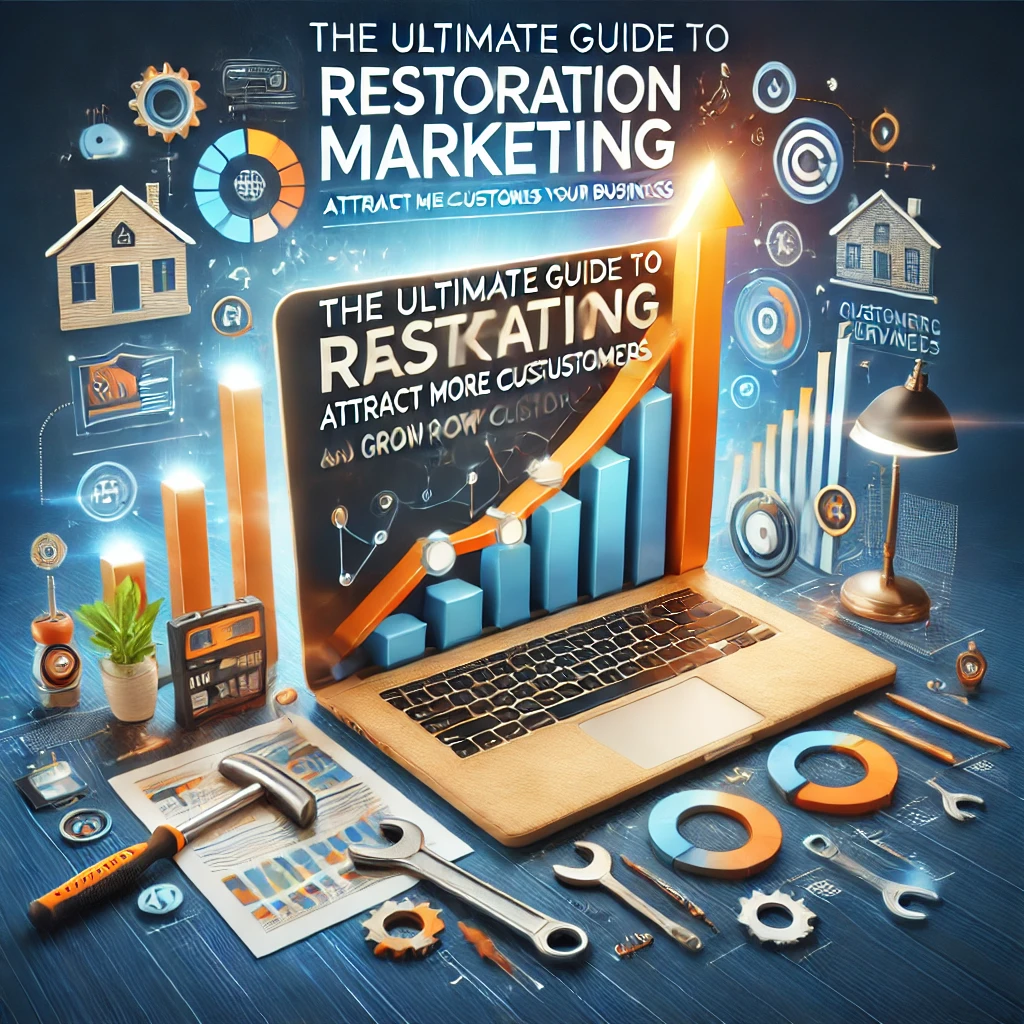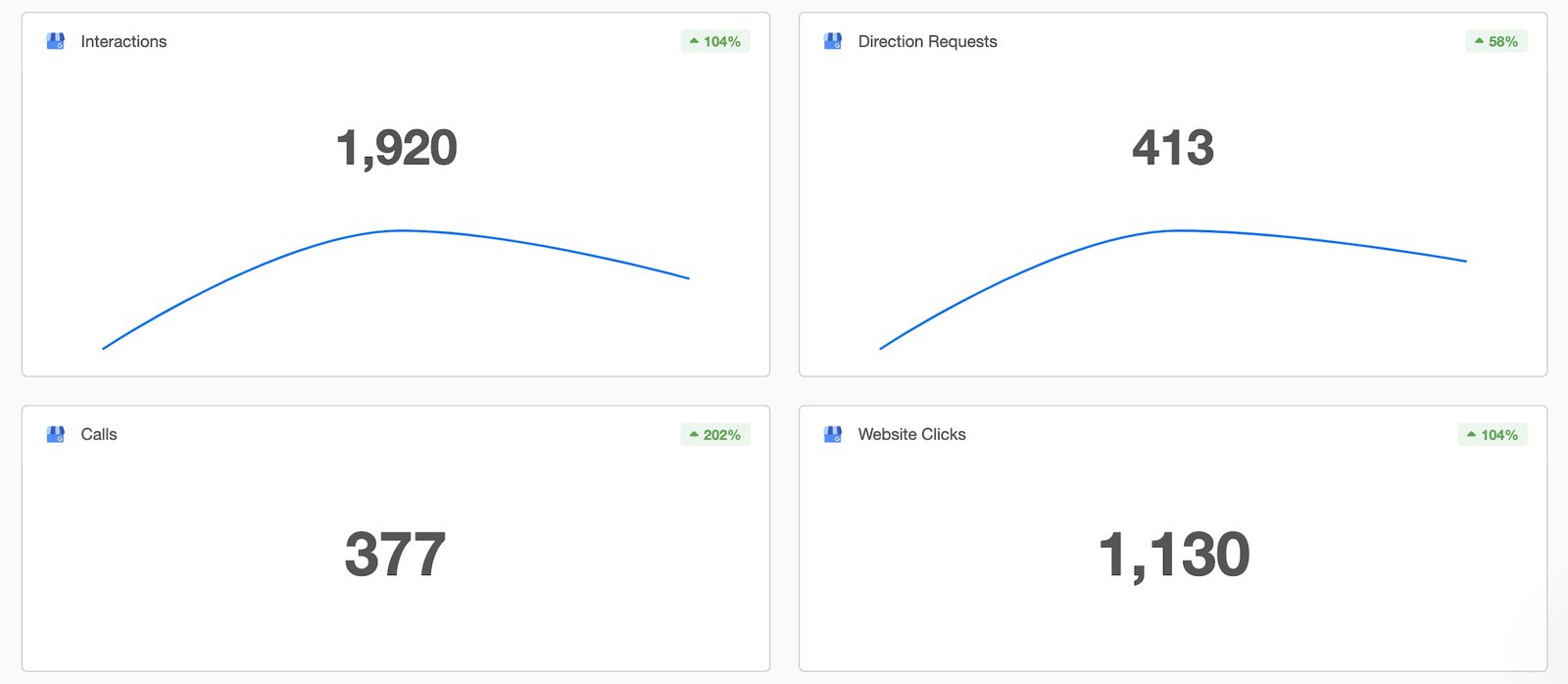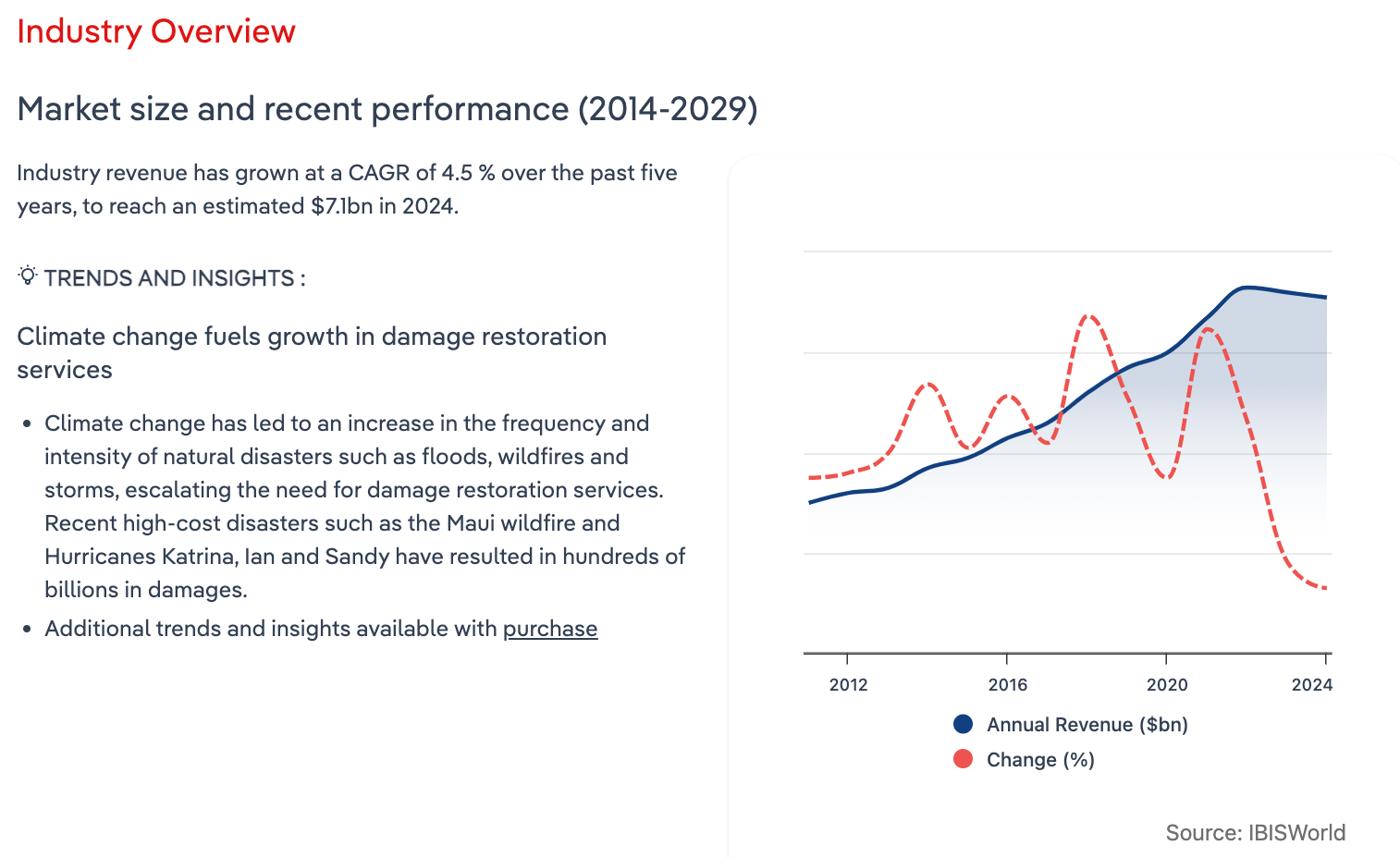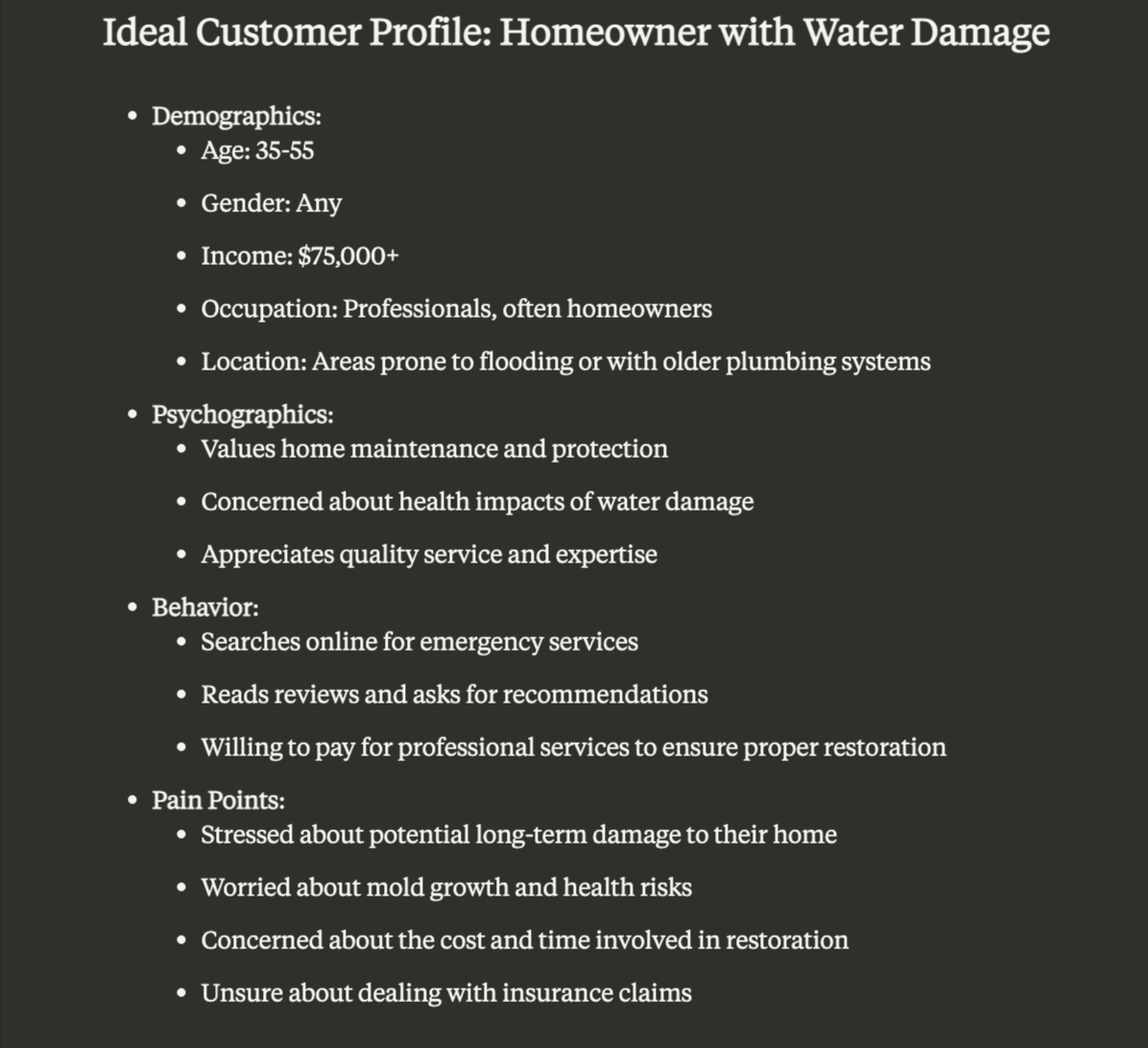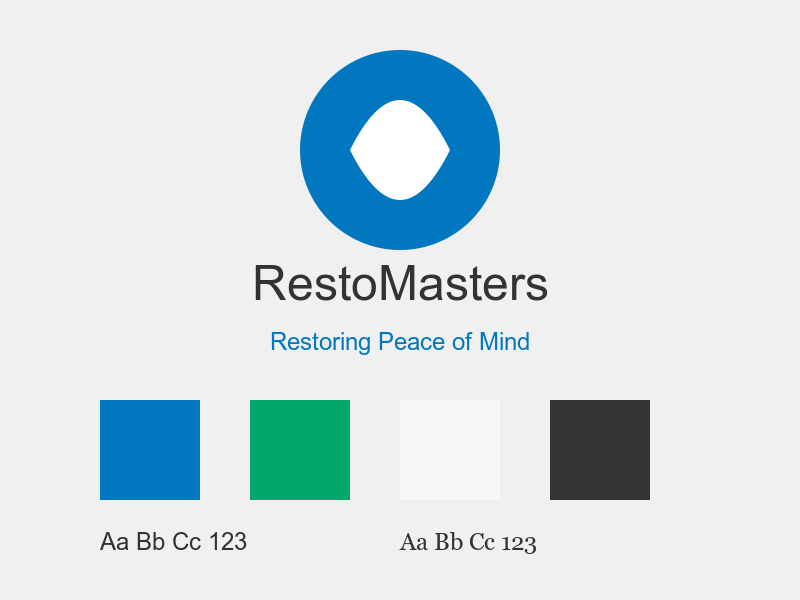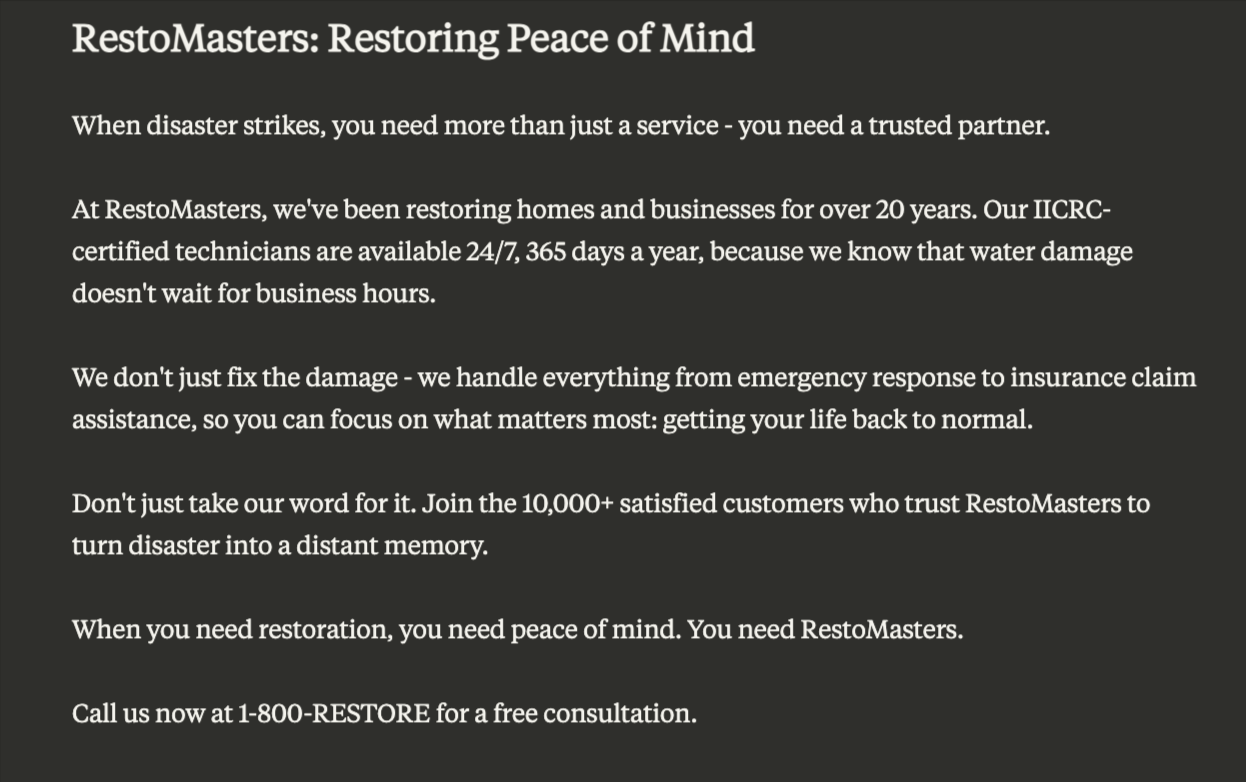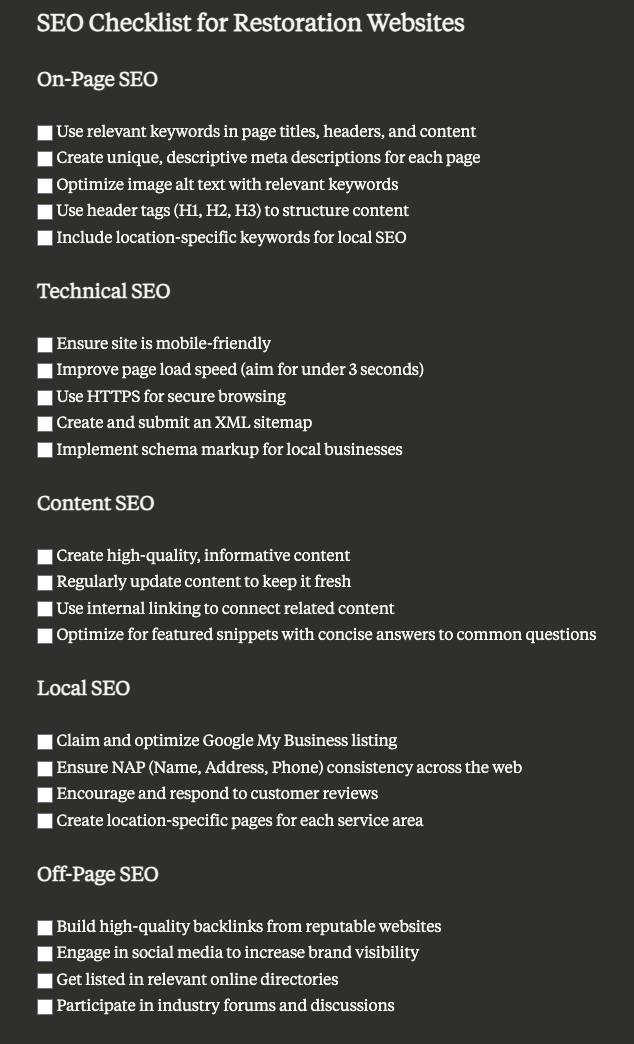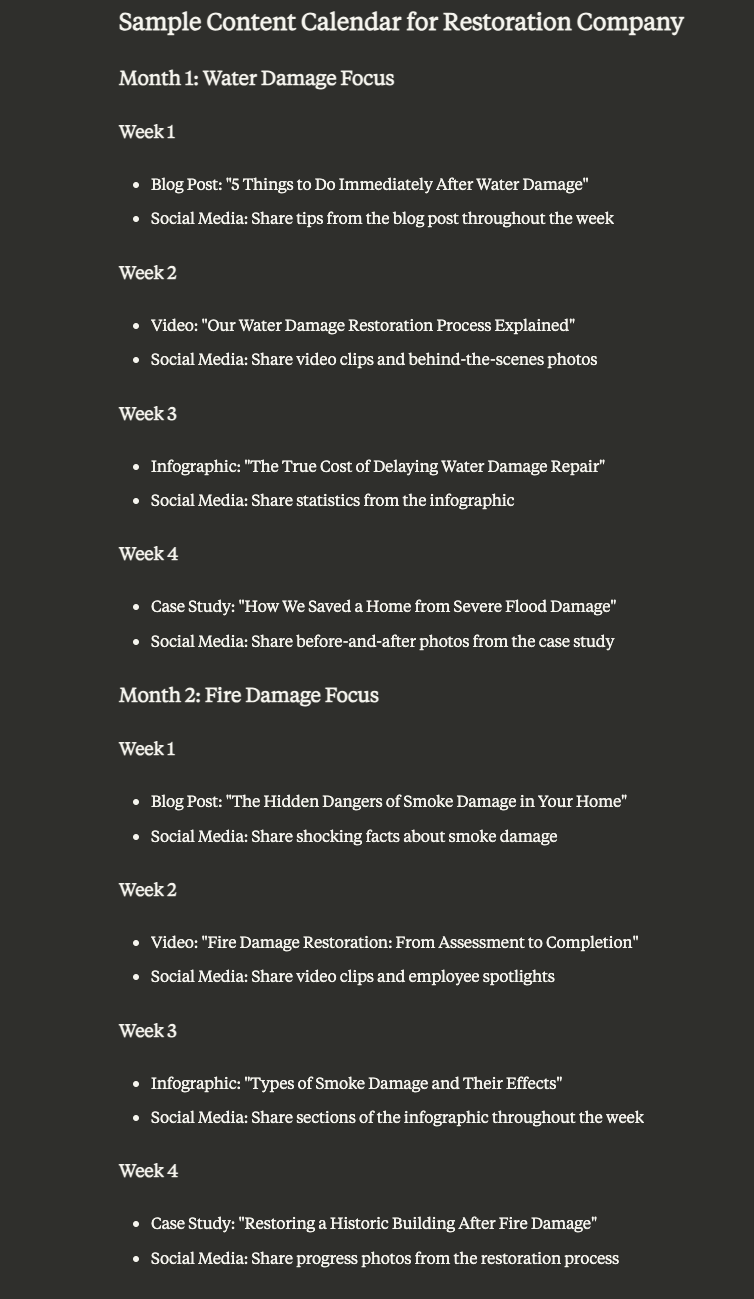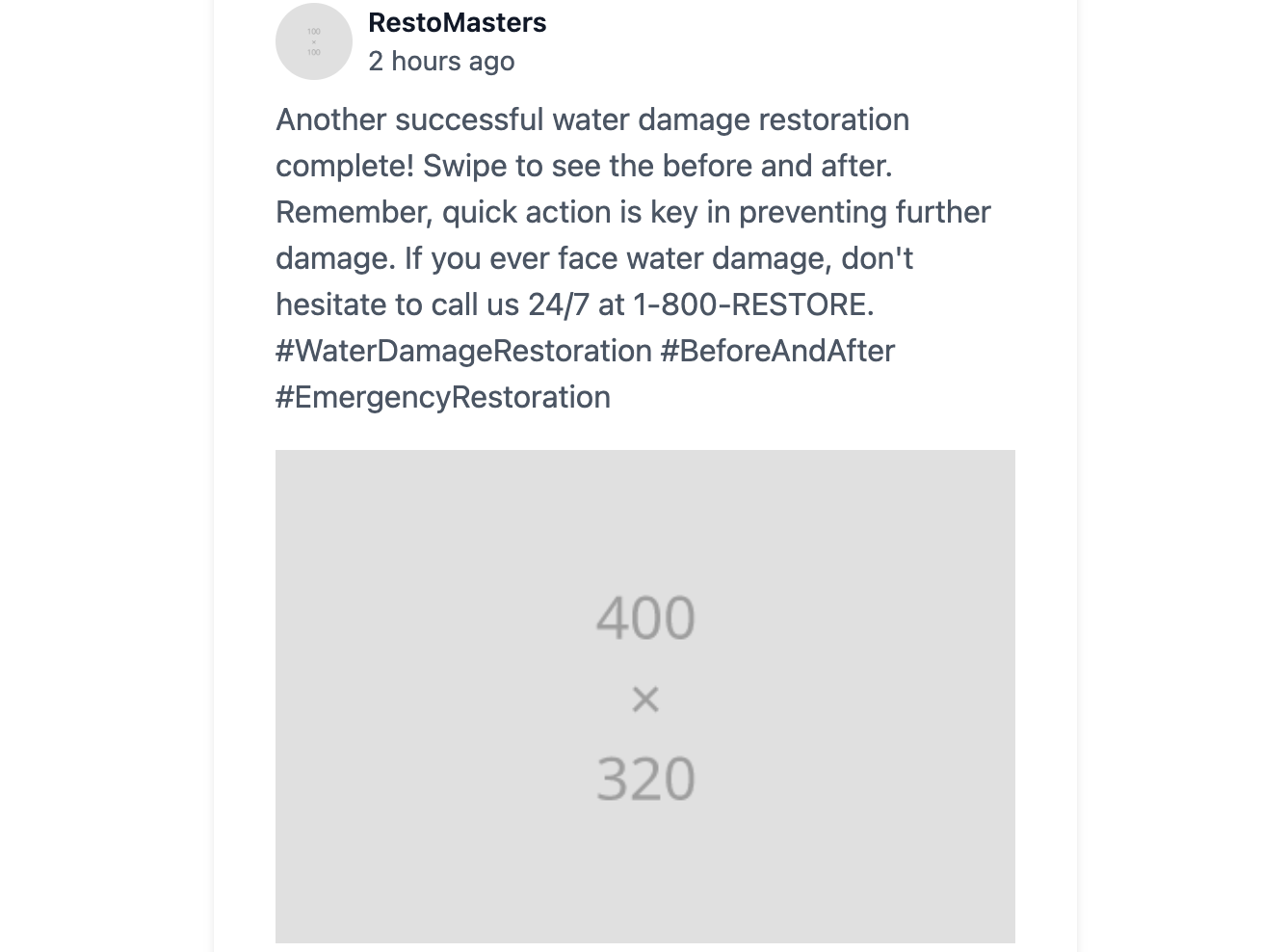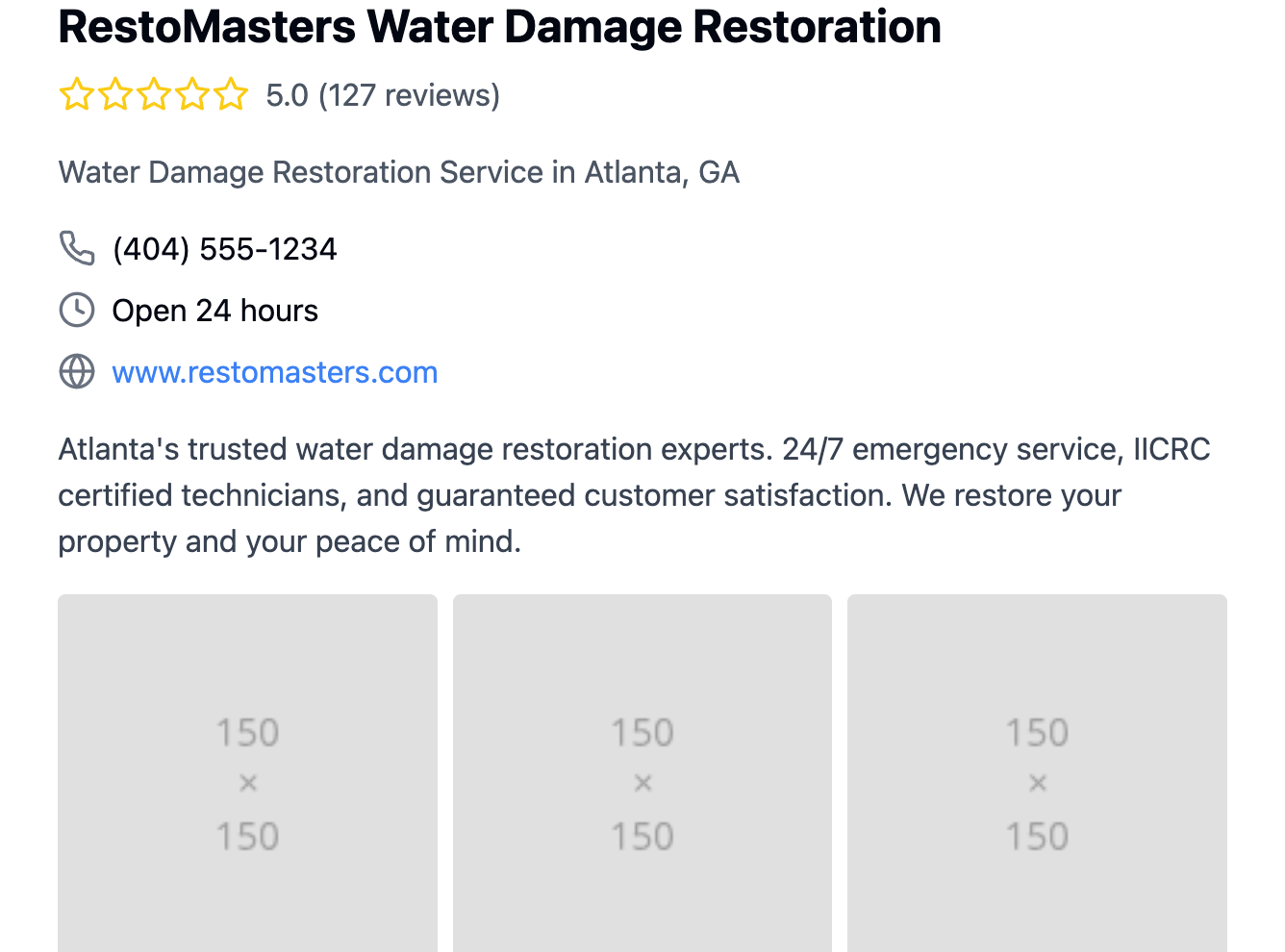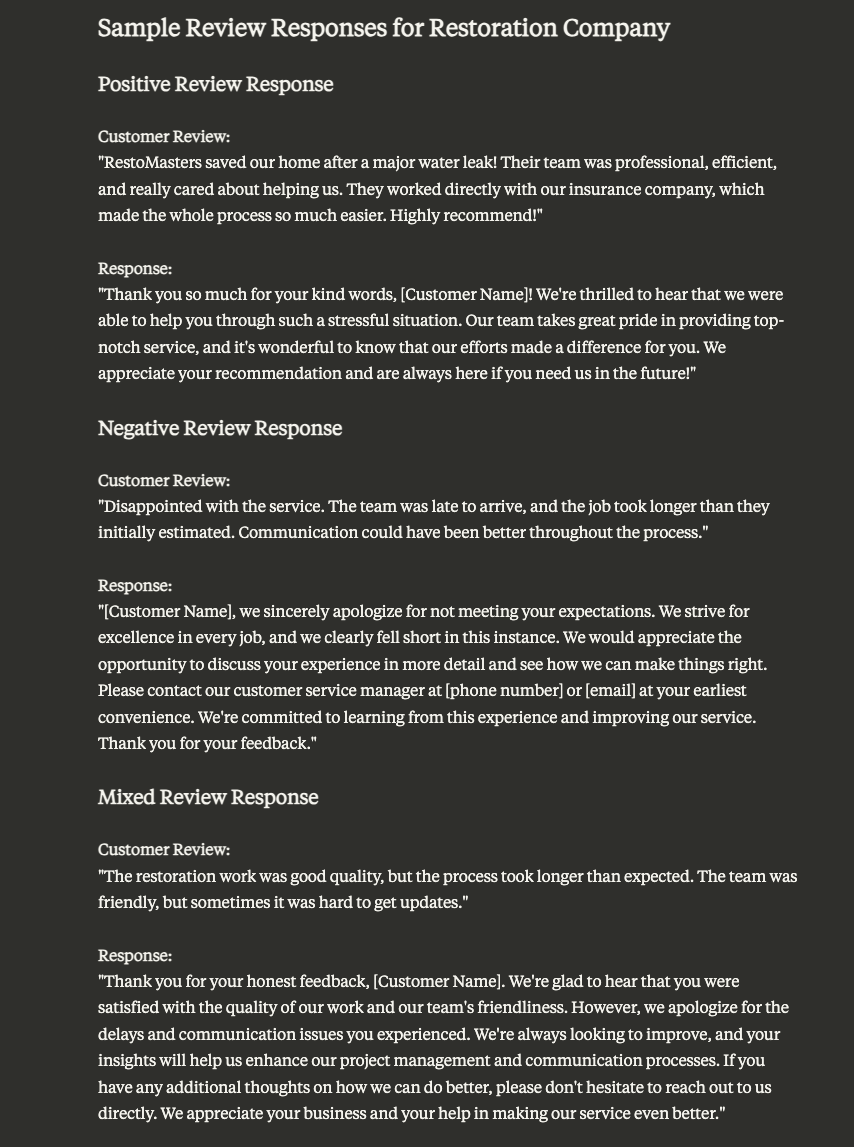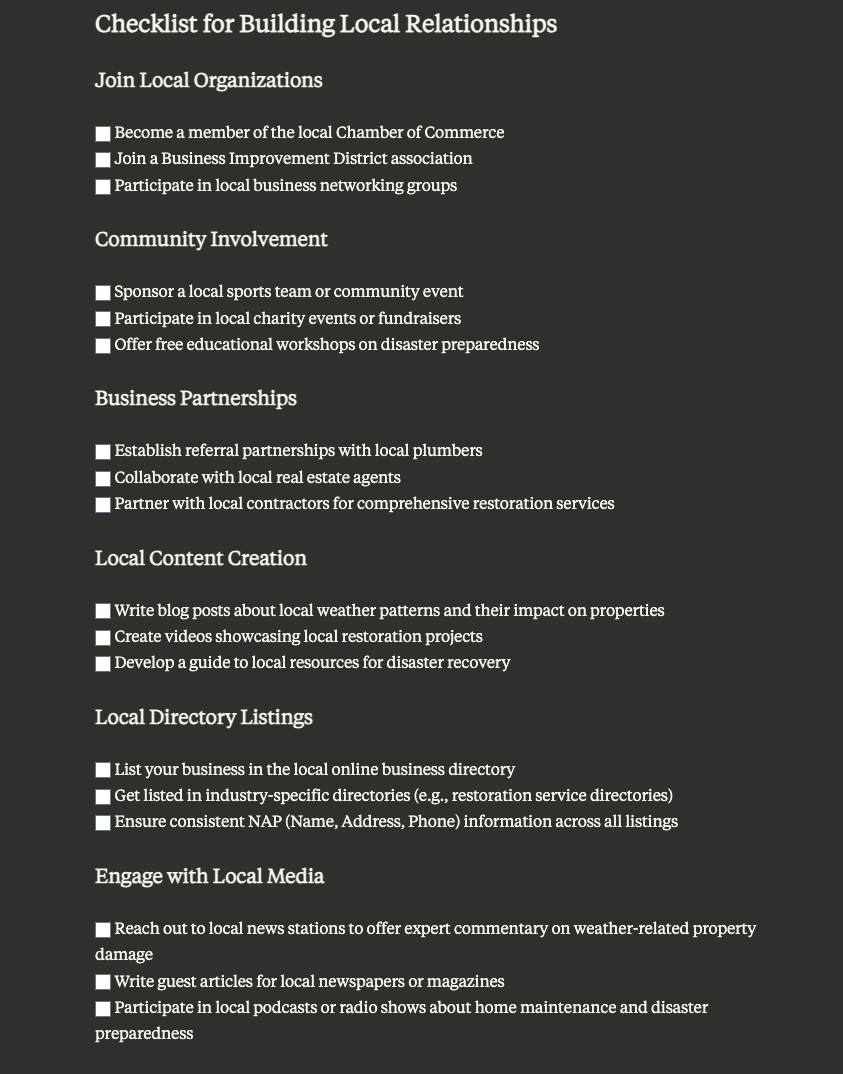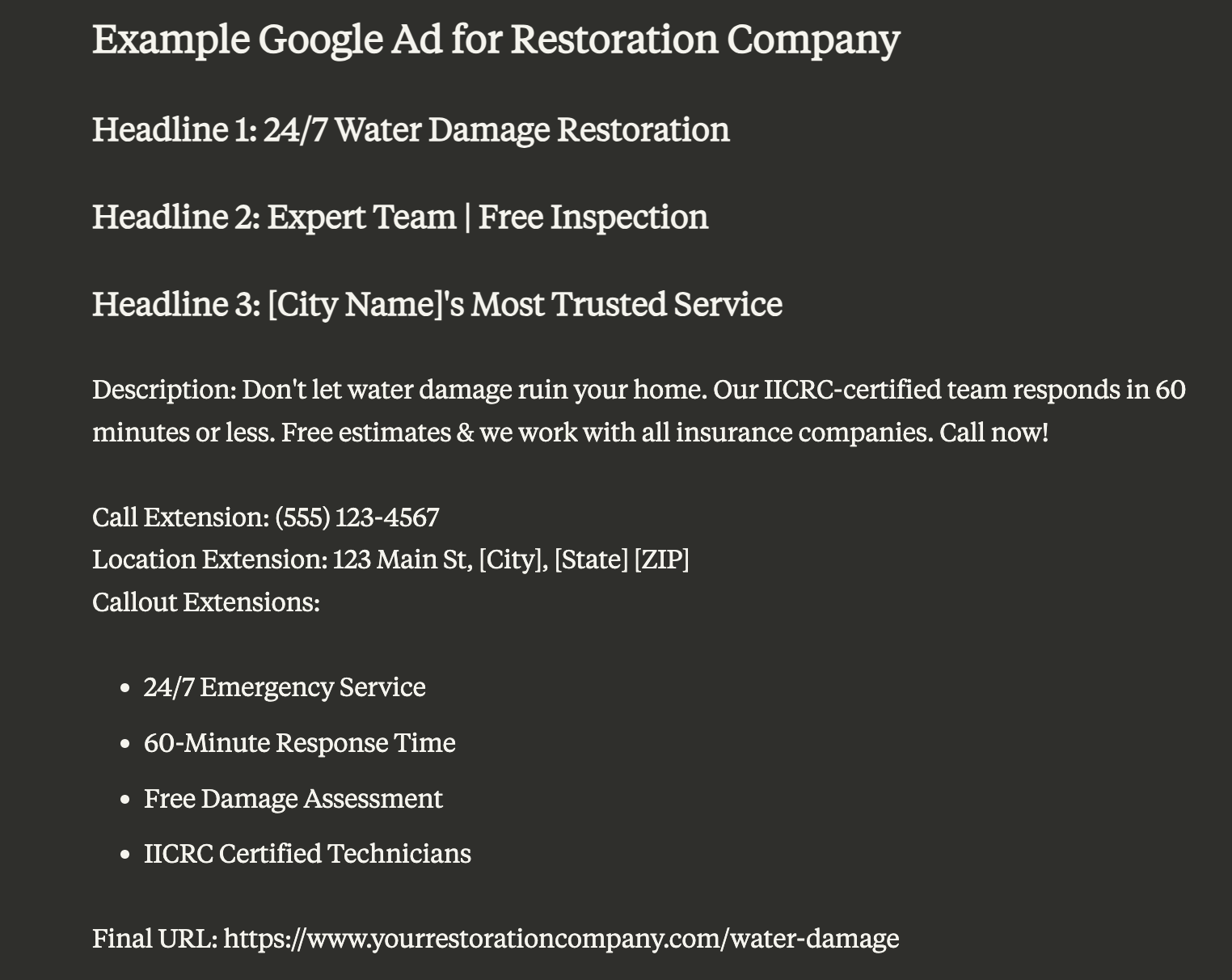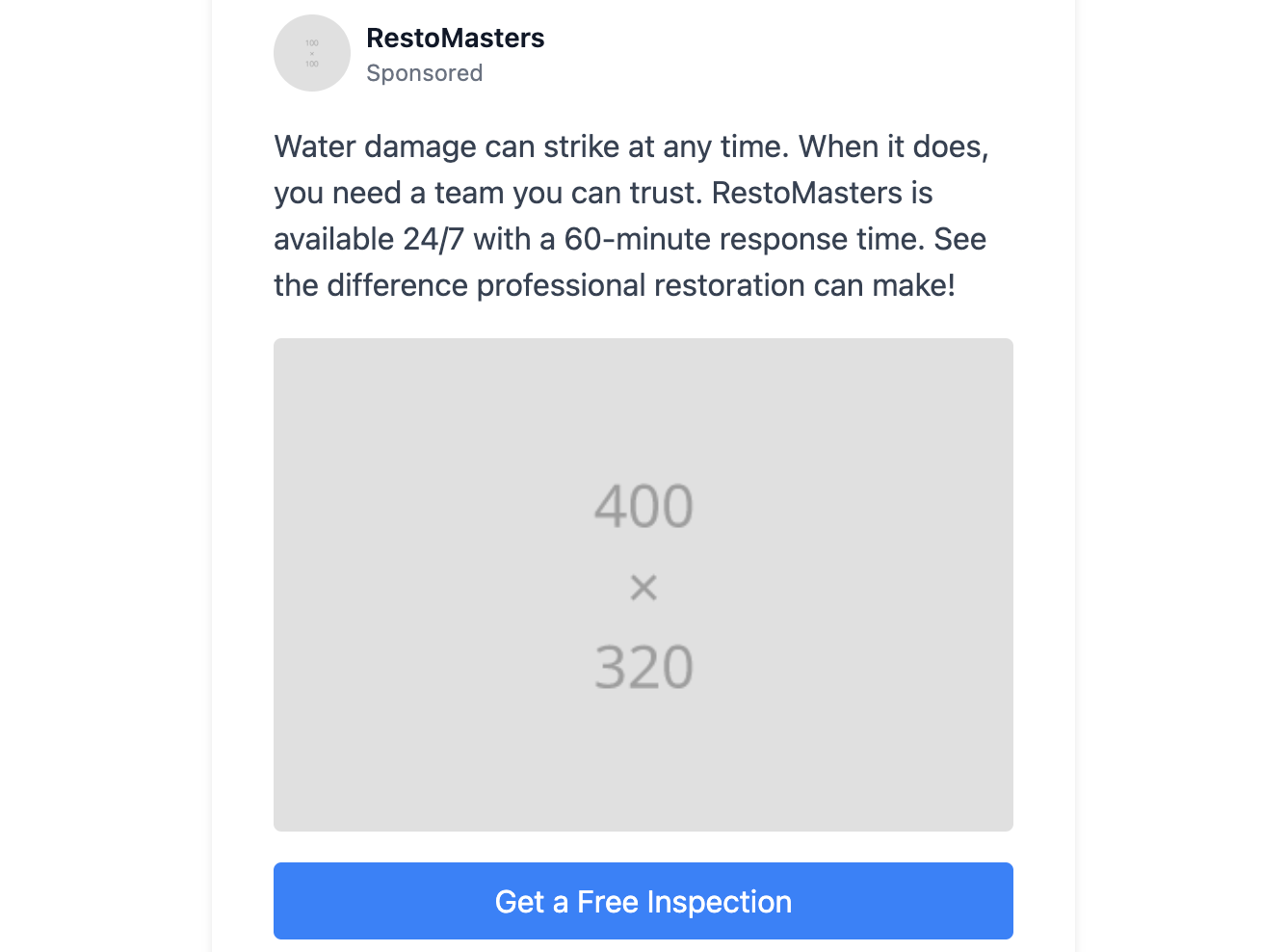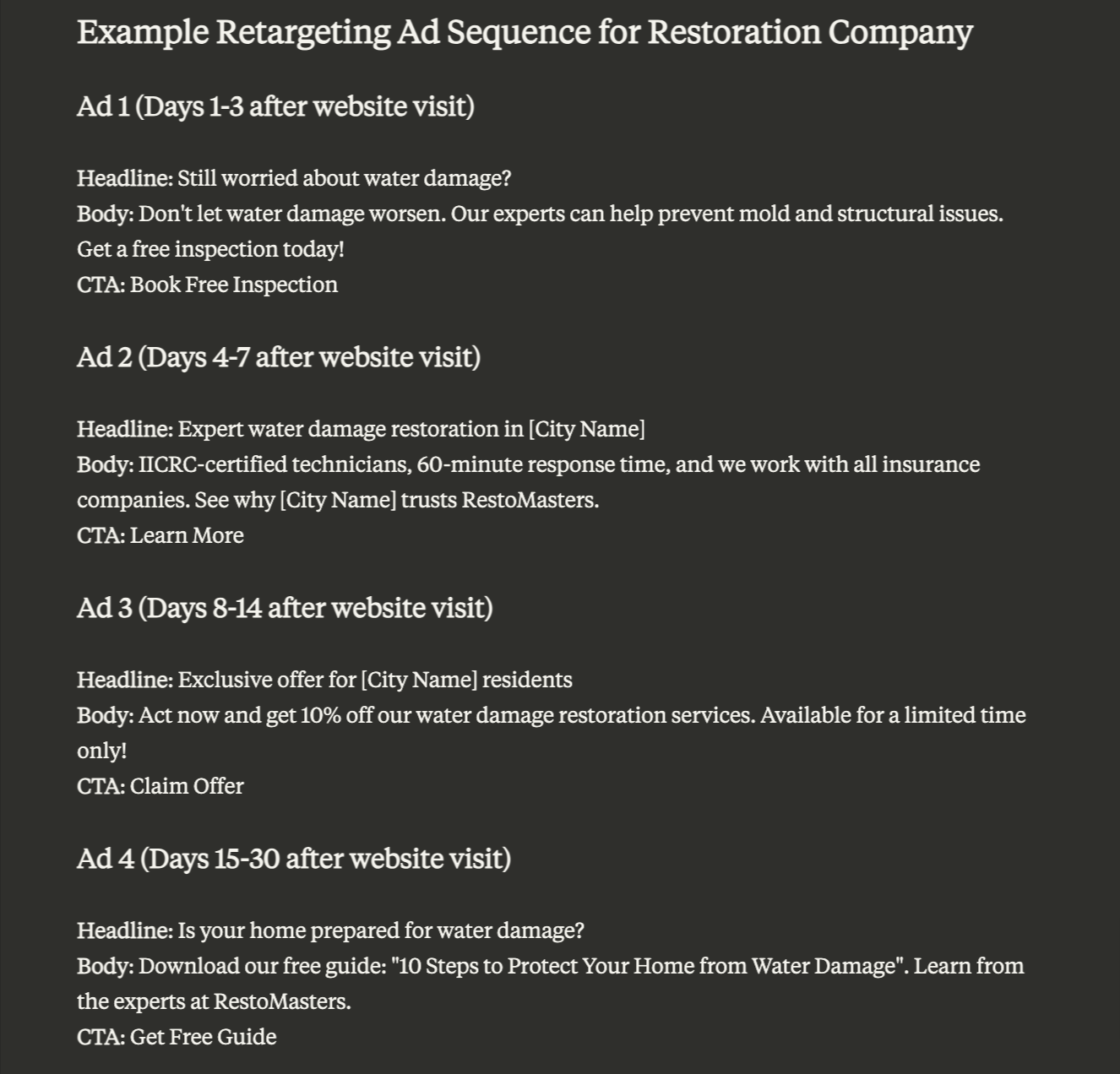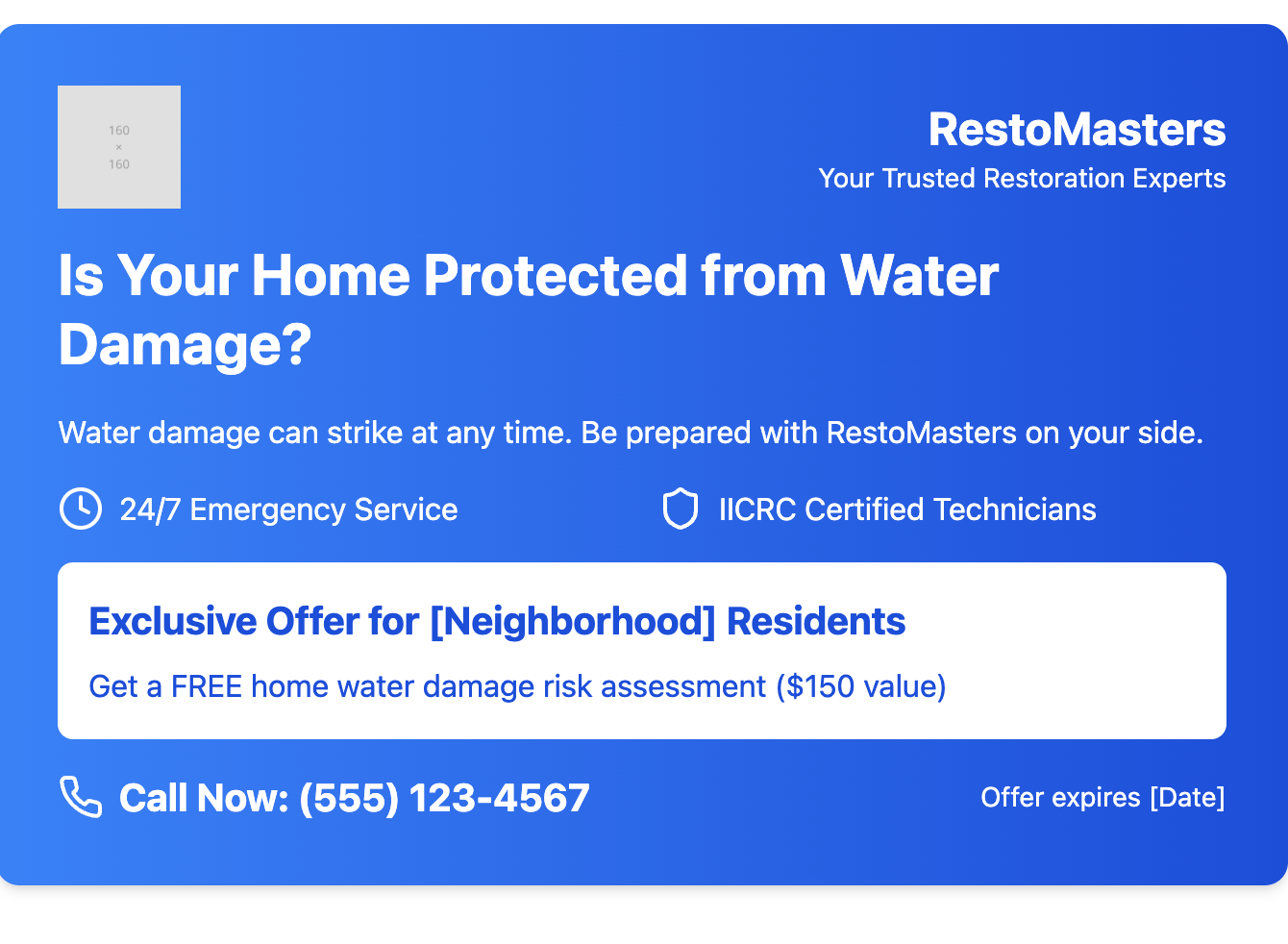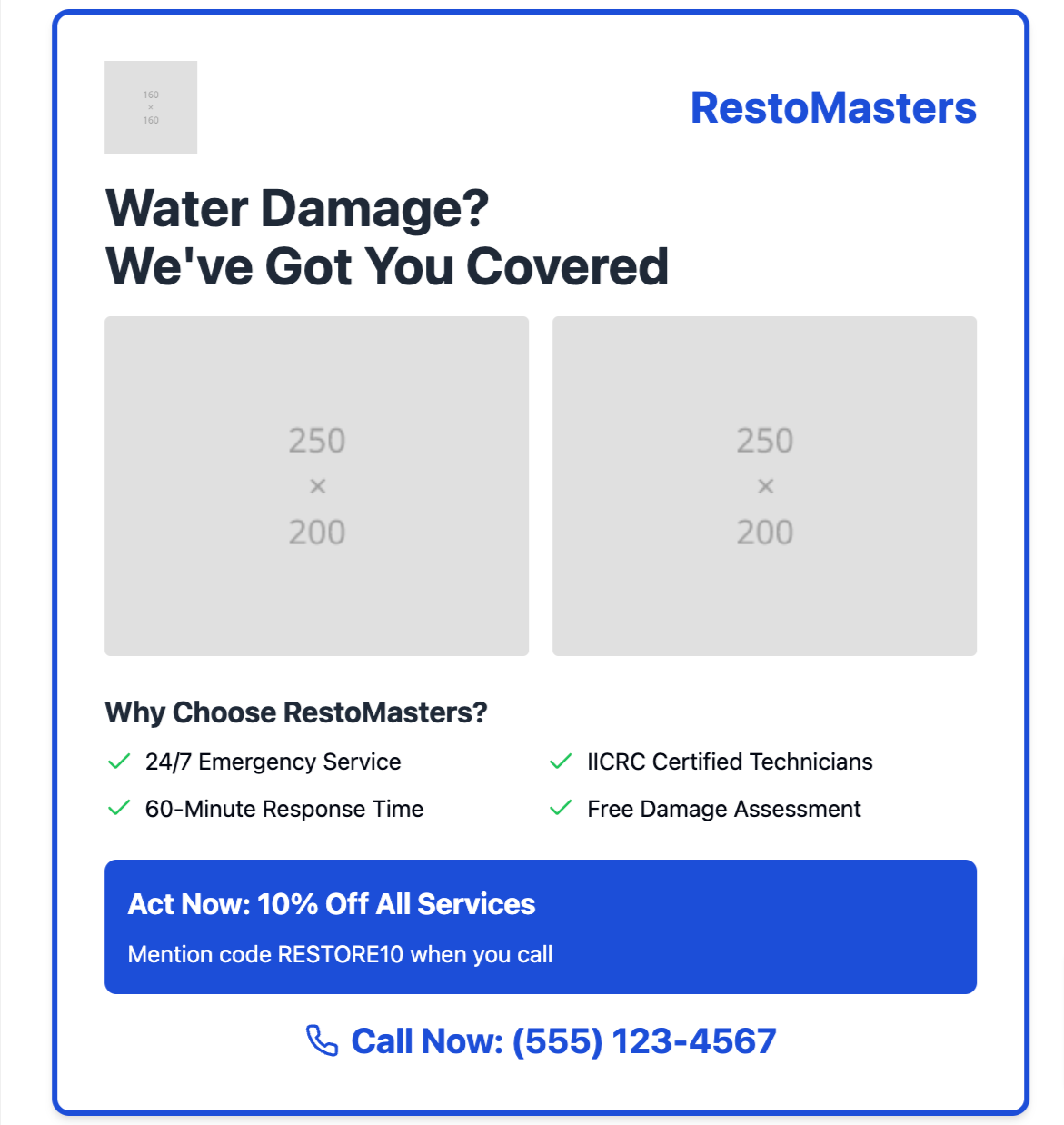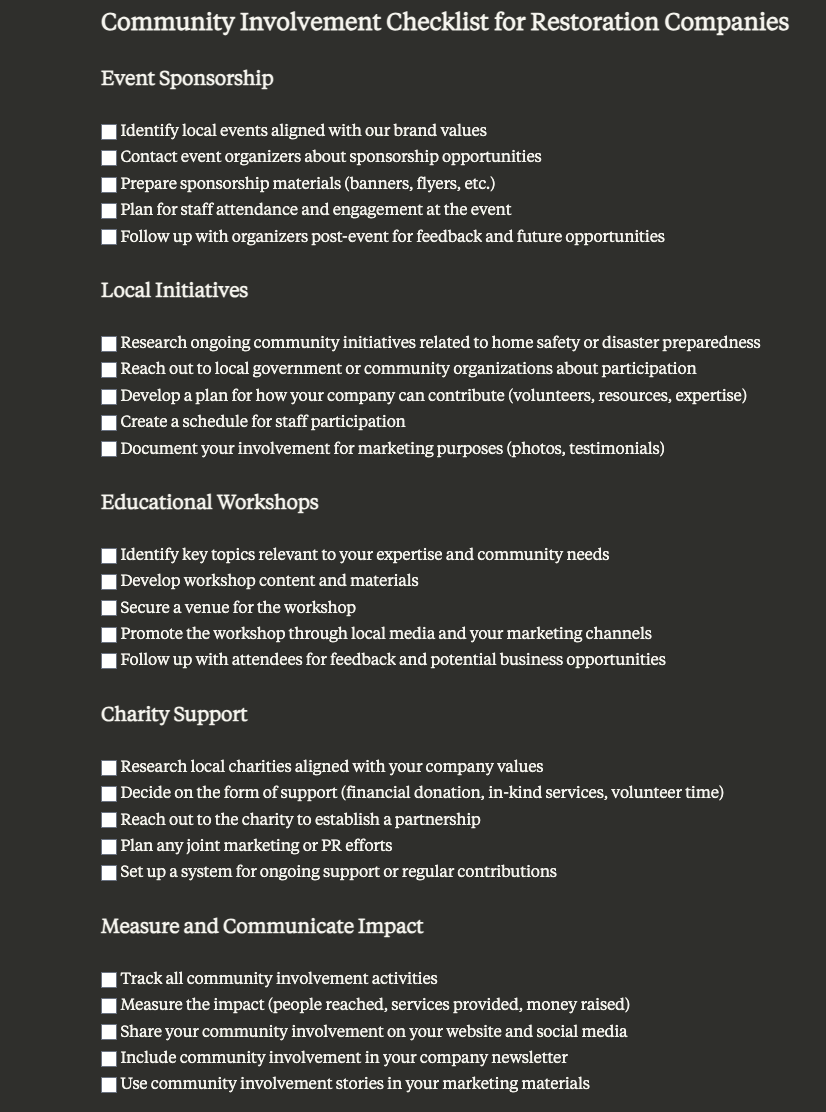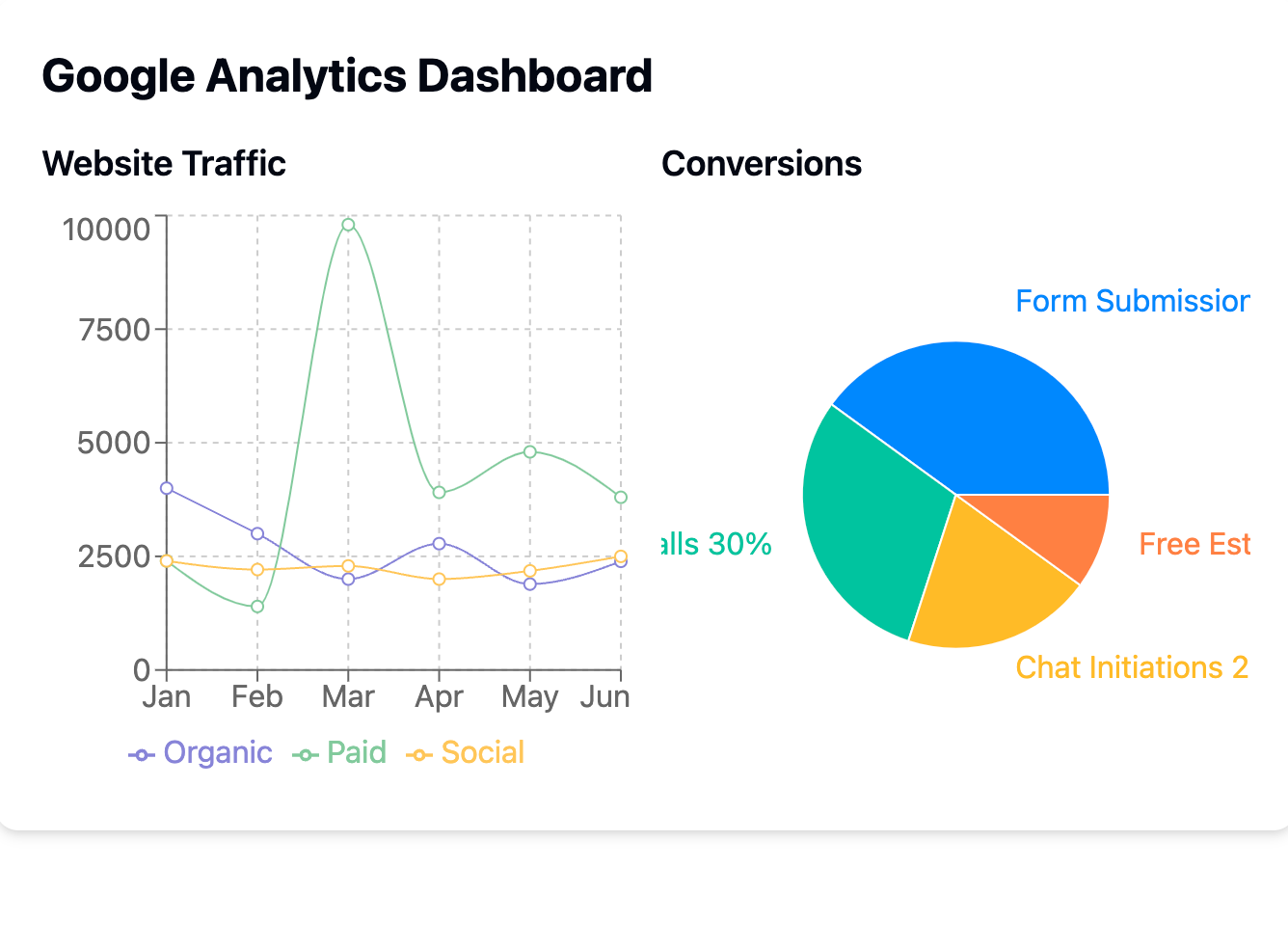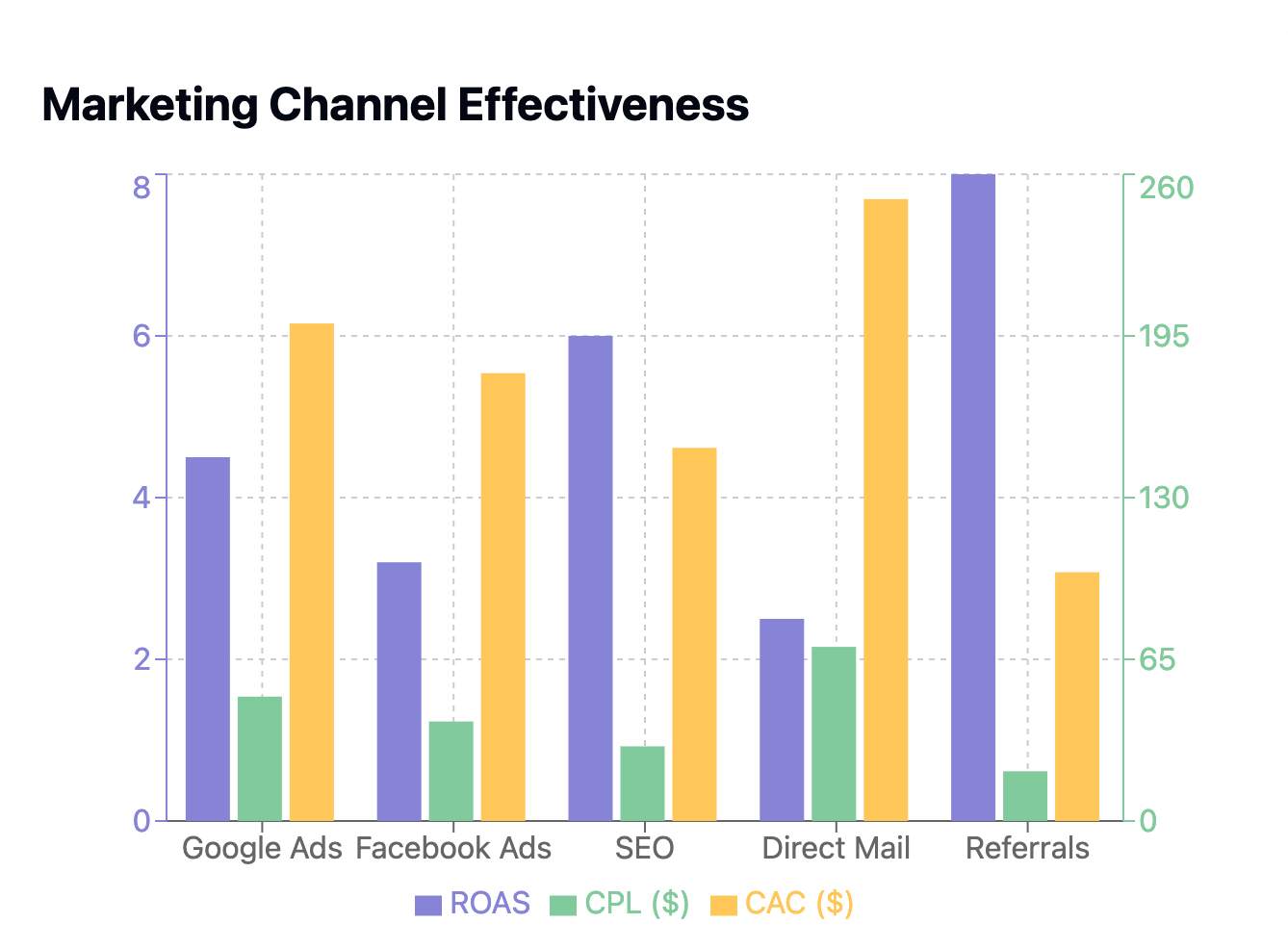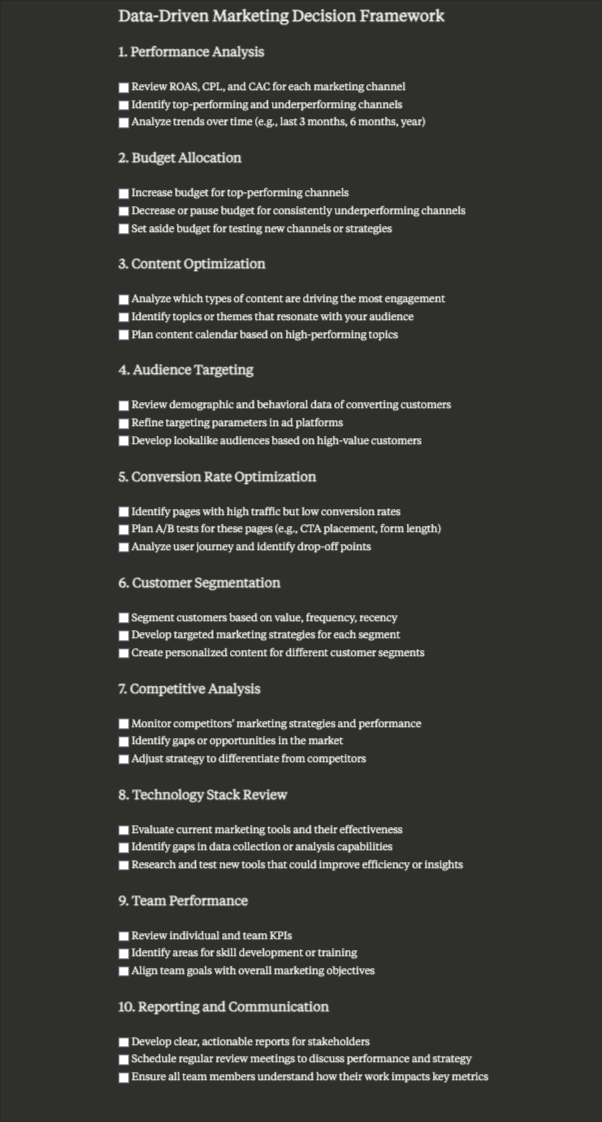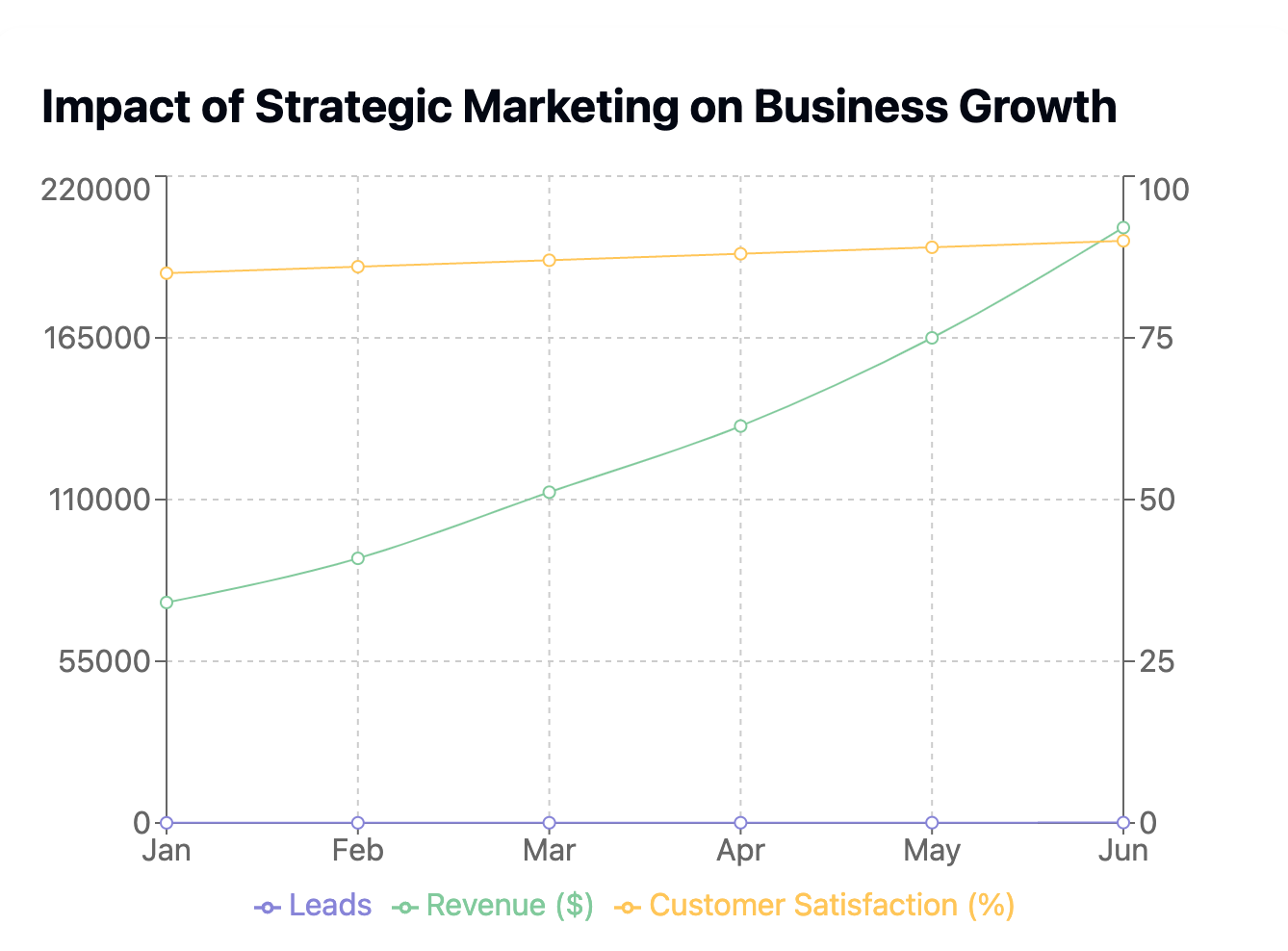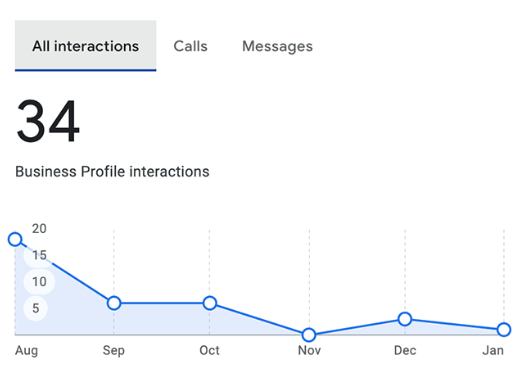Have you ever wondered how successful restoration companies seem to always have a steady stream of customers? The secret lies in their mastery of restoration marketing.
In this comprehensive guide, I’ll show you EXACTLY how to create a powerful restoration marketing strategy that will help your business thrive.
In fact, this is the same process I’ve used to help restoration companies increase their leads by over 200% in just six months:
So if you want to attract more customers and grow your restoration business in 2024 and beyond, you’ll love this new guide.
Table of Contents
ToggleWhat is Restoration Marketing?
Restoration marketing is the process of attracting customers who need repair or restoration services for their possessions or property. This can include everything from water damage restoration and fire damage repair to antique furniture restoration and classic car refurbishment.
But here’s the kicker:
Restoration marketing isn’t just about promoting your services. It’s about positioning your company as the go-to expert in your field and building trust with potential customers before they even need your services.
Why is Restoration Marketing So Important Today?
In today’s economy, restoration marketing has become more crucial than ever. Here’s why:
- Economic Concerns: With rising costs and economic uncertainty, many people are choosing to repair or restore items rather than replace them. This trend has created a booming market for restoration services.
- Environmental Awareness: As more people become environmentally conscious, the “repair and reuse” mentality is gaining traction. Restoration services align perfectly with this eco-friendly mindset.
- Nostalgia and Sentiment: There’s a growing appreciation for vintage and antique items, leading more people to seek restoration services for sentimental or valuable possessions.
- Disaster Preparedness: With increasing awareness of natural disasters, more property owners are seeking information about restoration services before they actually need them.
- Competition: The restoration industry is becoming more competitive. Effective marketing is essential to stand out and attract customers.
By mastering restoration marketing, you can tap into these trends and position your business for success. In the following steps, I’ll show you exactly how to do that.
Let’s dive in!
Step #1: Identify Your Target Audience
Here’s the truth:
The success of your restoration marketing efforts hinges on knowing EXACTLY who you’re trying to reach.
Why?
Because when you understand your ideal customer, you can create messages that resonate with them and offer services that meet their specific needs.
Let’s break this down:
Understanding Your Ideal Customer
First, you need to define who your ideal customer is. This goes beyond basic demographics – you need to dig deep into their needs, pain points, and motivations.
Here’s what you should consider:
- Demographics: Age, gender, income level, occupation, location
- Psychographics: Values, attitudes, interests, lifestyle
- Behavior: How they search for services, what influences their decisions
- Pain Points: What problems are they facing? What keeps them up at night?
For example, here’s a profile of an ideal customer for a water damage restoration company:
By creating a detailed profile like this, you can tailor your marketing messages to address these specific concerns and needs.
Identifying Specific Restoration Needs
Next, you need to identify the specific restoration needs of your target audience. This will help you focus your marketing efforts and highlight your expertise in the areas that matter most to your potential customers.
Common restoration needs include:
- Water damage restoration
- Fire and smoke damage repair
- Mold remediation
- Storm damage repair
- Biohazard cleanup
- Carpet and upholstery cleaning
- Document and electronics restoration
To identify which needs are most relevant to your target audience, consider:
- Local climate and weather patterns: Are you in an area prone to flooding, hurricanes, or wildfires?
- Local architecture: Are there many older homes with potential plumbing or electrical issues?
- Local industries: Are there businesses that might require specialized restoration services?
For example, if you’re located in Florida, you might focus heavily on water damage and hurricane restoration services. If you’re in California, fire damage restoration might be a key focus.
Pro Tip: Don’t try to be everything to everyone. By focusing on specific restoration needs, you can position yourself as an expert in those areas, which can lead to more targeted and effective marketing.
Putting It All Together
Once you’ve identified your ideal customer and their specific restoration needs, you can create targeted marketing campaigns that speak directly to their concerns.
For instance, if your ideal customer is a homeowner worried about water damage, you might create a campaign focused on:
- The long-term risks of untreated water damage
- The importance of quick response in preventing mold growth
- Your 24/7 emergency response service
- Your expertise in dealing with insurance companies
By tailoring your message this way, you’re more likely to attract the right customers and stand out from your competition.
Remember, understanding your target audience isn’t a one-time task. Keep refining your ideal customer profile as you learn more about your clients and as market conditions change.
In the next step, we’ll look at how to craft your unique value proposition based on this understanding of your target audience.
Step #2: Create a Powerful Brand Identity and Compelling Messaging
Here’s a hard truth:
In the restoration industry, your expertise alone isn’t enough to win customers. You need a strong brand identity and compelling messaging to stand out from the competition.
Why?
Because when disaster strikes, people don’t just look for a service – they look for a trusted partner. Your branding and messaging are what transform you from a faceless company into that trusted partner.
Let’s break this down:
Developing a Strong Brand Identity
Your brand identity is the face of your company. It’s what people see and remember about you.
Here are the key elements:
- Logo: This is the visual cornerstone of your brand. It should be simple, memorable, and reflect your company’s values.
- Colors: Choose a color palette that resonates with your brand personality. For restoration services, blues (trust, professionalism) and greens (growth, freshness) are popular choices.
- Tagline: A short, catchy phrase that encapsulates your unique value proposition.
- Typography: The fonts you use in your marketing materials should be consistent and reflect your brand personality.
- Imagery: The types of images you use in your marketing should align with your brand values and appeal to your target audience.
Let’s look at an example of how these elements come together:
This example brand identity for “RestoMasters” uses:
- A logo that combines a water droplet and a house, symbolizing protection and restoration
- A color palette of blue (trust, professionalism) and green (growth, freshness)
- A tagline that emphasizes the emotional benefit of their service
- Clean, professional typography
Remember, your brand identity should be consistent across all your marketing materials, from your website to your truck wraps.
Crafting Compelling Messaging
Once you have your brand identity, you need to craft messaging that resonates with your target audience. Here’s how:
- Highlight Your Expertise: Showcase your certifications, years of experience, and specialized knowledge. For example: “With over 20 years of experience and IICRC certification, we’re the experts you can trust.”
- Emphasize Reliability: In the restoration industry, quick response is crucial. Highlight your 24/7 availability and fast response times. For instance: “We’re there when you need us most – 24/7, 365 days a year.”
- Focus on Customer Satisfaction: Use testimonials and case studies to show how you’ve helped others. For example: “Join the 10,000+ homeowners we’ve helped recover from water damage.”
- Address Pain Points: Remember the pain points we identified in Step #1? Address them directly in your messaging. For instance: “From emergency response to insurance claim assistance, we handle it all so you don’t have to.”
- Use Emotional Appeal: Restoration is often needed in stressful situations. Show empathy and position your service as a solution. For example: “We don’t just restore homes. We restore peace of mind.”
Here’s an example of how these elements might come together in a marketing message:
This message incorporates all the key elements we discussed:
- It highlights expertise (20 years of experience, IICRC certification)
- It emphasizes reliability (24/7 availability)
- It focuses on customer satisfaction (10,000+ satisfied customers)
- It addresses pain points (handling everything from emergency response to insurance claims)
- It uses emotional appeal (restoring peace of mind)
Pro Tip: Test different versions of your messaging to see what resonates best with your audience. This could be as simple as trying different subject lines in your emails or headlines on your landing pages.
Putting It All Together
Your brand identity and messaging should work together to create a cohesive brand experience. Every touchpoint with your customer – from your website to your phone greeting – should reflect your brand identity and reinforce your key messages.
Remember, branding and messaging aren’t set-it-and-forget-it tasks. They should evolve as your company grows and as you learn more about what resonates with your customers.
In the next step, we’ll look at how to choose the right marketing channels to get your newly crafted brand and message in front of your target audience.
Step #3: Dominate Your Online Presence
Let’s face it:
In today’s digital age, your online presence is often the first (and sometimes only) impression potential customers have of your restoration business.
But here’s the kicker:
Having a website isn’t enough. You need a strong, optimized online presence that attracts, engages, and converts potential customers.
In this step, I’ll show you exactly how to create an online presence that puts you leagues ahead of your competition.
Let’s break it down:
Website Optimization: Your Digital Storefront
Your website is the cornerstone of your online presence. Here’s how to make it work for you:
- Search Engine Optimization (SEO) SEO is crucial for getting your website in front of potential customers when they search for restoration services. Here are some key SEO tactics:
-
- Use relevant keywords throughout your site (e.g., “water damage restoration [your city]”)
- Create location-specific pages for each area you serve
- Optimize your page titles and meta descriptions
- Ensure your site loads quickly (Google loves fast sites!)
- User-Friendly Design Your website should be easy to navigate and provide a great user experience. Here’s what to focus on:
- Clear, intuitive navigation
- Prominent contact information and call-to-action buttons
- Fast loading times (aim for under 3 seconds)
- Easy-to-read fonts and color schemes
- Clear, high-quality images (especially before-and-after photos)
- Mobile Responsiveness With over 50% of web traffic coming from mobile devices, your site MUST be mobile-friendly. This means:
- Responsive design that adapts to different screen sizes
- Large, easy-to-tap buttons for mobile users
- Simplified navigation for smaller screens
- Fast loading times on mobile networks
Pro Tip: Use Google’s Mobile-Friendly Test to check if your site is optimized for mobile devices.
Content Marketing: Showcase Your Expertise
Content marketing is your opportunity to demonstrate your expertise and provide value to potential customers. Here’s how to do it right:
- Blog Posts: Write informative articles about restoration topics. For example:
-
- “5 Things to Do Immediately After Water Damage”
- “The Hidden Dangers of Smoke Damage in Your Home”
- “How to Prevent Mold Growth After Flooding”
- Videos: Create helpful video content. Ideas include:
-
- Step-by-step guides for minor repairs
- Explanations of your restoration process
- Customer testimonials
- Infographics: Visual content can be highly shareable. Try creating infographics on topics like:
-
- “The Restoration Process: From Damage to Recovery”
- “Water Damage by the Numbers: Statistics You Need to Know”
- “Types of Smoke Damage and Their Effects”
- Case Studies: Showcase your successful projects. Structure them like this:
-
- The problem (describe the damage)
- Your solution (detail your restoration process)
- The results (include before-and-after photos)
Remember, the key to successful content marketing is consistency. Create a content calendar and stick to it!
Social Media Engagement: Build Relationships
Social media is not just about promoting your services – it’s about building relationships with your community. Here’s how to make the most of it:
- Choose the Right Platforms: Focus on platforms where your target audience is most active. For restoration businesses, Facebook and Instagram are often good choices.
- Share Valuable Content: Don’t just promote your services. Share tips, industry news, and behind-the-scenes glimpses of your work.
- Showcase Your Work: Before-and-after photos are extremely effective on social media. They visually demonstrate the value of your services.
- Engage with Your Audience: Respond promptly to comments and messages. This shows that you’re attentive and care about your customers.
- Use Hashtags: Research and use relevant hashtags to increase the visibility of your posts. For example: #WaterDamageRestoration #EmergencyRestoration #[YourCity]Restoration
- Run Contests or Giveaways: These can boost engagement and increase your follower count. For example, you could give away a free mold inspection.
- Leverage User-Generated Content: Encourage satisfied customers to share their experiences and tag your business.
Here’s an example of an effective social media post for a restoration company:
This post incorporates several best practices:
- It showcases a successful project with before-and-after photos
- It provides valuable information (the importance of quick action)
- It includes a call-to-action (the phone number)
- It uses relevant hashtags to increase visibility
Putting It All Together
A strong online presence is about creating a cohesive experience across all digital touchpoints. Your website, content, and social media should all work together to reinforce your brand message and showcase your expertise.
Remember, building a strong online presence is an ongoing process. Regularly update your website, consistently create valuable content, and stay active on social media to keep your online presence fresh and engaging.
In the next step, we’ll look at how to leverage paid advertising to amplify your online presence and reach even more potential customers.
Step #4: Master Local SEO and Reputation Management
Here’s a fact that might surprise you:
97% of people learn more about a local company online than anywhere else.
And get this:
88% of consumers trust online reviews as much as personal recommendations.
What does this mean for your restoration business?
It means that mastering local SEO and managing your online reputation isn’t just important – it’s absolutely crucial for your success.
In this step, I’ll show you exactly how to dominate local search results and build a five-star reputation that attracts customers like a magnet.
Let’s dive in:
Claiming and Optimizing Your Google Business Profile
Your Google Business Profile (formerly known as Google My Business) is the cornerstone of your local SEO efforts. Here’s how to make it work for you:
- Claim Your Listing: If you haven’t already, go to Google Business Profile and claim your listing. It’s free and takes just a few minutes.
- Complete EVERY Section: The more information you provide, the better. Here’s what to focus on:
- Business name, address, and phone number (NAP)
- Business category (e.g., “Water Damage Restoration Service”)
- Service area
- Business hours (including special hours for holidays)
- Services you offer
- Photos of your business, team, and completed projects
- Use Keywords in Your Description: Include relevant keywords like “water damage restoration,” “fire damage repair,” or “mold remediation” in your business description.
- Add Posts Regularly: Share updates, offers, or events through Google Posts. This keeps your profile fresh and engaging.
- Respond to Q&As: Monitor and respond to questions asked through your Google Business Profile. This shows you’re attentive and helps potential customers.
Here’s an example of what a well-optimized Google Business Profile might look like:
This profile includes all the key elements: complete business information, keywords in the description, high ratings, and visual content.
Pro Tip: Use Google’s Business Profile Management tool to monitor and update your profile regularly. This helps ensure your information stays accurate and up-to-date.
Encouraging and Responding to Online Reviews
Online reviews are the lifeblood of local businesses. Here’s how to make them work for you:
- Ask for Reviews: Don’t be shy about asking satisfied customers to leave a review. You can do this in person, via email, or even through a text message after completing a job.
- Make It Easy: Provide direct links to your Google Business Profile or other review sites. The easier you make it, the more likely customers are to follow through.
- Respond to ALL Reviews: Whether positive or negative, respond to every review. This shows that you value customer feedback.
- Address Negative Reviews Professionally: If you receive a negative review, respond calmly and professionally. Offer to take the conversation offline to resolve the issue.
- Showcase Reviews on Your Website: Feature positive reviews on your website to build trust with potential customers.
Here’s an example of how to respond to a positive review:
These responses demonstrate empathy, professionalism, and a commitment to customer satisfaction.
Building Relationships with Local Businesses and Organizations
Local relationships can significantly boost your local SEO efforts and overall business. Here’s how to build them:
- Join Local Business Organizations: Become a member of your local chamber of commerce or business improvement district.
- Participate in Community Events: Sponsor local events or participate in community service projects.
- Collaborate with Complementary Businesses: Partner with local plumbers, contractors, or real estate agents for mutual referrals.
- Create Local Content: Write blog posts or create videos about local events or issues related to property damage in your area.
- Get Listed in Local Directories: Ensure your business is listed in local online directories and industry-specific directories.
Here’s a quick checklist for building local relationships:
By completing these tasks, you’ll not only improve your local SEO but also become a trusted member of your local business community.
Putting It All Together
Mastering local SEO and reputation management is an ongoing process. Regularly update your Google Business Profile, consistently ask for and respond to reviews, and continually work on building local relationships.
Remember, in the restoration industry, trust is everything. By establishing a strong local presence and stellar reputation, you’re not just improving your SEO – you’re building a foundation of trust that will attract customers and keep them coming back.
In the next step, we’ll explore how to leverage paid advertising to complement your organic SEO efforts and reach even more potential customers.
Step #5: Supercharge Your Growth with Paid Advertising
Here’s a hard truth:
Organic marketing efforts are crucial, but they can take time to yield results. And in the fast-paced world of restoration, you need to be visible NOW.
That’s where paid advertising comes in.
With the right paid advertising strategy, you can:
- Get in front of potential customers right when they need you
- Rapidly increase your visibility and brand awareness
- Precisely target your ideal customers
- See immediate results and ROI
In this step, I’ll show you exactly how to create a paid advertising strategy that will supercharge your restoration business growth.
Let’s dive in:
Google Ads: Be There When They Need You Most
Google Ads is a powerhouse for restoration businesses. Why? Because when people have water damage or fire damage, they often turn to Google first.
Here’s how to make Google Ads work for you:
- Target Relevant Keywords: Focus on high-intent keywords like:
- “emergency water damage restoration [city]”
- “fire damage repair near me”
- “24/7 flood cleanup services”
- Use Ad Extensions: These give your ads more real estate and provide additional information. Key extensions for restoration businesses include:
- Call extensions (add your phone number)
- Location extensions (show your address)
- Callout extensions (highlight key selling points like “24/7 Service” or “Free Estimates”)
- Create Compelling Ad Copy: Your ad should highlight your unique value proposition and include a strong call-to-action. For example:
- Set Up Conversion Tracking: This allows you to see which ads are driving phone calls, form submissions, and other valuable actions.
- Use Geo-Targeting: Limit your ads to the specific areas you serve to avoid wasting budget on irrelevant clicks.
Pro Tip: Set up call-only ads for mobile devices. In emergency situations, people often prefer to call directly rather than visit a website.
Social Media Advertising: Build Brand Awareness and Trust
While Google Ads captures people actively searching for your services, social media advertising helps you build brand awareness and trust. Here’s how to approach it:
- Choose the Right Platforms: For restoration businesses, Facebook and Instagram are often the most effective.
- Use Compelling Visuals: Before-and-after photos or short videos of your restoration process can be very effective.
- Target Strategically: Use Facebook’s detailed targeting options to reach homeowners in your service area. You can target based on:
- Location
- Age
- Home ownership status
- Interests related to home improvement
- Create Different Ad Sets: Develop separate ad sets for different services (water damage, fire damage, mold remediation) and for different objectives (brand awareness vs. lead generation).
Here’s an example of what a Facebook ad for a restoration company might look like:
This ad uses a compelling before-and-after image, highlights key selling points (24/7 availability, 60-minute response time), and includes a clear call-to-action.
Retargeting Campaigns: Don’t Let Leads Slip Away
Retargeting (also known as remarketing) allows you to show ads to people who have previously visited your website. This is crucial because:
- It keeps your brand top-of-mind
- It gives you another chance to convert visitors who didn’t take action on their first visit
- It’s often more cost-effective than targeting cold traffic
Here’s how to set up effective retargeting campaigns:
- Install Retargeting Pixels: Place the Facebook Pixel and Google Ads retargeting tag on your website.
- Create Segmented Audiences: For example:
- People who visited your water damage page
- People who started but didn’t complete a contact form
- People who haven’t visited in the last 30 days
- Craft Tailored Messages: Create ads specific to each segment. For example, for someone who visited your water damage page but didn’t convert, you might show an ad highlighting your water damage expertise and offering a free inspection.
- Set Frequency Caps: Limit how often each user sees your ads to avoid ad fatigue.
- Use Multiple Platforms: Retarget on both Google (through the Display Network) and social media platforms for maximum reach.
Here’s an example of a retargeting ad sequence:
This sequence keeps your brand top-of-mind while providing value and increasingly compelling offers to encourage action.
Putting It All Together
An effective paid advertising strategy combines these different approaches:
- Use Google Ads to capture high-intent searches
- Leverage social media advertising to build brand awareness and trust
- Implement retargeting to stay top-of-mind and increase conversions
Remember, the key to successful paid advertising is continuous testing and optimization. Regularly review your ad performance, test different ad copies and images, and adjust your targeting to improve your results over time.
Pro Tip: Consider using a tool like Semrush to help manage and optimize your Google Ads campaigns. It can provide valuable insights into keyword performance and competitor strategies.
In the next step, we’ll explore how to measure and analyze your marketing efforts to ensure you’re getting the best possible return on your investment.
Step #6: Leverage Traditional Marketing for Local Impact
Here’s something that might surprise you:
In the age of digital marketing, many restoration businesses are overlooking a goldmine of opportunity: traditional marketing.
Why does this matter?
Because while your competitors are fighting for online attention, you can make a real, tangible impact in your local community through traditional marketing methods.
In this step, I’ll show you exactly how to use traditional marketing to complement your digital efforts and create a powerful, multi-channel marketing strategy.
Let’s dive in:
Direct Mail: Making a Physical Connection
Direct mail might seem old-school, but it’s experiencing a renaissance. Here’s why:
- It’s tangible, making it more memorable than digital ads
- It has less competition than overflowing email inboxes
- It can be highly targeted to specific neighborhoods or demographics
Here’s how to make direct mail work for your restoration business:
- Choose the Right Format: Options include:
- Postcards: Great for quick, eye-catching messages
- Flyers: Ideal for more detailed information
- Brochures: Perfect for showcasing your services and expertise
- Target Strategically: Focus on:
- Neighborhoods prone to flooding or other natural disasters
- Areas with older homes (more likely to need restoration services)
- Recent homebuyers in your service area
- Craft Compelling Content: Your mail piece should:
- Highlight your unique value proposition
- Include a strong call-to-action
- Offer something of value (e.g., a free inspection or disaster preparedness guide)
- Track Results: Use unique phone numbers or landing page URLs to measure the effectiveness of your campaigns
Here’s an example of what an effective direct mail postcard might look like:
This postcard includes key elements like a compelling headline, unique value propositions, a special offer, and a clear call-to-action.
Pro Tip: Consider using variable data printing to personalize each piece with the recipient’s name or address. This can significantly increase engagement rates.
Print Advertising: Reach Local Audiences
While digital advertising dominates, print advertising still has its place, especially for local businesses. Here’s how to make it work:
- Choose the Right Publications: Focus on:
- Local newspapers
- Community magazines
- Industry publications (e.g., real estate or home improvement magazines)
- Design Eye-Catching Ads: Your ad should:
- Have a clear, attention-grabbing headline
- Include high-quality images (before-and-after photos work well)
- Highlight your unique selling points
- Include a clear call-to-action
- Consider Advertorials: These are ads designed to look like editorial content. They can be more engaging and informative than traditional display ads.
- Track Performance: Use unique phone numbers or offer codes to measure the effectiveness of your print ads.
Here’s an example of what an effective print ad might look like:
This ad includes attention-grabbing visuals, clear value propositions, and a special offer to encourage action.
Community Involvement: Building Trust and Awareness
Community involvement is about more than just marketing – it’s about building relationships and establishing your business as a trusted local partner. Here’s how to do it effectively:
- Sponsor Local Events: This could include:
- Youth sports teams
- Charity runs or walks
- Community festivals
- Participate in Local Initiatives: Get involved in:
- Community clean-up days
- Disaster preparedness programs
- Home safety initiatives
- Host Educational Workshops: Offer free seminars on topics like:
- Home maintenance tips to prevent water damage
- What to do in case of a fire
- How to spot signs of mold
- Support Local Charities: Choose causes that align with your business, such as:
- Disaster relief organizations
- Housing charities
- Environmental conservation groups
Here’s a checklist to help you plan your community involvement:
By following this checklist, you can ensure that your community involvement is strategic, impactful, and aligned with your business goals.
Putting It All Together
An effective traditional marketing strategy combines these different approaches:
- Use direct mail to make a tangible connection with potential customers
- Leverage print advertising to reach local audiences
- Engage in community involvement to build trust and awareness
Remember, the key to successful traditional marketing is consistency and integration with your digital efforts. Your traditional marketing should reinforce your online presence, and vice versa.
Pro Tip: Create a unified campaign that spans both digital and traditional channels. For example, you could run a “Disaster Preparedness Month” campaign that includes social media posts, a direct mail piece, a print ad, and a community workshop all focused on the same theme.
In the next step, we’ll explore how to measure and analyze your marketing efforts across all channels to ensure you’re getting the best possible return on your investment.
Step #7: Master the Art of Measuring and Analyzing Your Marketing Results
Here’s a hard truth:
If you’re not measuring your marketing efforts, you’re just guessing.
And in the competitive world of restoration, guesswork won’t cut it.
But here’s the good news:
With the right approach to measurement and analysis, you can:
- Identify what’s working (and what’s not)
- Optimize your marketing spend for maximum ROI
- Make data-driven decisions that propel your business forward
In this step, I’ll show you exactly how to measure and analyze your marketing results like a pro.
Let’s dive in:
Tracking Website Traffic, Leads, and Conversions
Your website is often the first point of contact between your business and potential customers. Here’s how to ensure you’re tracking its performance effectively:
- Set Up Google Analytics: This free tool is essential for understanding your website traffic. Here’s what to focus on:
- Traffic Sources: Where are your visitors coming from? (organic search, paid ads, social media, etc.)
- Bounce Rate: Are visitors engaging with your content or leaving immediately?
- Time on Site: How long are visitors staying on your site?
- Most Visited Pages: Which pages are most popular?
- Track Conversions: Set up goal tracking in Google Analytics to monitor key actions like:
- Contact form submissions
- Phone call clicks
- Chat initiations
- Free estimate requests
- Use UTM Parameters: These help you track the effectiveness of specific campaigns or ads by adding extra information to your URLs.
Here’s an example of what a Google Analytics dashboard for a restoration company might look like:
This dashboard provides a quick overview of website traffic sources and conversion types, allowing you to spot trends and areas for improvement at a glance.
Pro Tip: Set up custom dashboards in Google Analytics to focus on the metrics that matter most to your business. This can save you time and help you spot important trends more quickly.
Monitoring Social Media Engagement and Online Reviews
Social media and online reviews are crucial for building trust and attracting customers. Here’s how to track their performance:
- Social Media Metrics: Focus on:
- Reach: How many people are seeing your posts?
- Engagement: Likes, comments, shares
- Click-through rate: Are people visiting your website from social media?
- Follower growth: Is your audience expanding?
- Online Reviews: Monitor:
- Overall rating on platforms like Google, Yelp, and Facebook
- Number of new reviews
- Sentiment of reviews (positive, negative, neutral)
- Response rate and time to your reviews
- Use Social Media Management Tools: Platforms like Hootsuite or Sprout Social can help you track these metrics across multiple platforms in one place.
Here’s a sample social media and review tracking spreadsheet:
This spreadsheet allows you to track key social media and review metrics over time, making it easy to spot trends and areas for improvement.
Analyzing the Effectiveness of Different Marketing Channels
To optimize your marketing spend, you need to understand which channels are driving the best results. Here’s how:
- Use Multi-Channel Attribution: This helps you understand how different marketing touchpoints contribute to conversions. Google Analytics offers several attribution models:
- Last Click
- First Click
- Linear
- Time Decay
- Position Based
- Calculate Return on Ad Spend (ROAS): For each channel, divide the revenue generated by the amount spent on advertising.
- Track Cost Per Lead (CPL): Divide your total spend on a channel by the number of leads it generated.
- Monitor Customer Acquisition Cost (CAC): Calculate how much it costs to acquire a customer through each channel.
Here’s an example of how you might compare the effectiveness of different channels:
This chart allows you to quickly compare the ROAS, CPL, and CAC across different marketing channels, helping you identify which channels are most effective for your business.
Making Data-Driven Decisions to Optimize Marketing Strategies
Once you have all this data, it’s time to put it to use. Here’s how to make data-driven decisions:
- Identify Top Performing Channels: Look for channels with high ROAS and low CPL/CAC. Consider allocating more budget to these channels.
- Optimize Underperforming Channels: For channels with low performance, analyze why they’re underperforming. Can they be improved, or should you reallocate that budget?
- A/B Test: Continuously test different ad copy, images, landing pages, etc. to improve performance.
- Focus on High-Value Customers: Use your data to identify characteristics of your most valuable customers, and tailor your marketing to attract similar prospects.
- Adjust Based on Seasonality: Look for seasonal trends in your data and adjust your marketing strategy accordingly.
- Regular Reporting: Create weekly or monthly reports to track progress and identify trends over time.
Here’s a sample decision-making framework:
Conclusion: Elevate Your Restoration Business with Strategic Marketing
We’ve covered a lot of ground in this guide to restoration marketing. Let’s recap the key strategies that can transform your business:
- Identify Your Target Audience: Understanding your ideal customer is the foundation of all your marketing efforts.
- Create a Powerful Brand Identity: A strong brand sets you apart in a crowded market and builds trust with potential customers.
- Dominate Your Online Presence: From SEO to content marketing, your online presence is often your first impression on potential customers.
- Master Local SEO and Reputation Management: Local visibility and positive reviews are crucial for a restoration business.
- Leverage Paid Advertising: Strategic use of Google Ads, social media advertising, and retargeting can rapidly increase your visibility.
- Don’t Neglect Traditional Marketing: Direct mail, print ads, and community involvement can complement your digital efforts.
- Measure and Analyze Your Results: Data-driven decision making is key to optimizing your marketing strategy.
But here’s the thing:
The world of marketing is constantly evolving. What works today might not work tomorrow. That’s why it’s crucial to:
- Stay informed about new marketing trends and technologies
- Regularly review and adjust your marketing strategies
- Be willing to experiment with new approaches
Remember, investing in marketing is investing in the growth of your business. It’s not just about attracting more customers – it’s about attracting the right customers, building lasting relationships, and establishing your business as a trusted leader in the restoration industry.
To drive this point home, let’s look at the potential impact of effective marketing on a restoration business:
As you can see, effective marketing can lead to:
- Increased leads and customer inquiries
- Higher revenue as you attract more (and better) customers
- Improved customer satisfaction as you attract the right customers and set clear expectations
But remember, these results don’t happen overnight. Successful marketing requires consistent effort, continuous learning, and a willingness to adapt.
So, are you ready to take your restoration business to the next level?
Here’s your action plan:
- Review each section of this guide and identify areas where your current marketing strategy could improve.
- Create a prioritized list of marketing initiatives based on your business goals and resources.
- Start implementing these strategies, beginning with the highest priority items.
- Set up systems to track your results (as discussed in Step #7).
- Regularly review your performance and adjust your strategy as needed.
Remember, in the world of restoration, being there when customers need you is everything. With a solid marketing strategy, you’ll not only be there – you’ll be the first choice they think of when disaster strikes.
Now, it’s time to put this knowledge into action. Your future customers are out there, waiting to hear from you. Go make it happen!
Final Pro Tip: Consider working with a marketing professional or agency that specializes in the restoration industry. They can help you implement these strategies more quickly and effectively, potentially accelerating your results.
Thank you for reading this comprehensive guide to restoration marketing. Here’s to your success and growth in the restoration industry!
Ready to Accelerate Your Restoration Marketing Success?
While this guide provides a solid foundation, implementing a comprehensive marketing strategy can be challenging, especially when you’re focused on running your restoration business. That’s where Uptick Creative comes in.
As specialists in restoration marketing, we understand the unique challenges and opportunities in your industry. Our team of experts can help you:
- Develop a customized, data-driven marketing strategy
- Implement effective search engine marketing campaigns
- Create compelling content that resonates with your target audience
- Build a strong online presence that drives high-quality leads
- Track and analyze your results for continuous improvement
Don’t let the complexities of digital marketing hold your business back. Partner with Uptick Creative and watch your restoration business thrive.
Take the First Step Towards Marketing Success
Contact Uptick Creative today for a free, no-obligation consultation. We’ll review your current marketing efforts and provide actionable insights to help your business grow.

